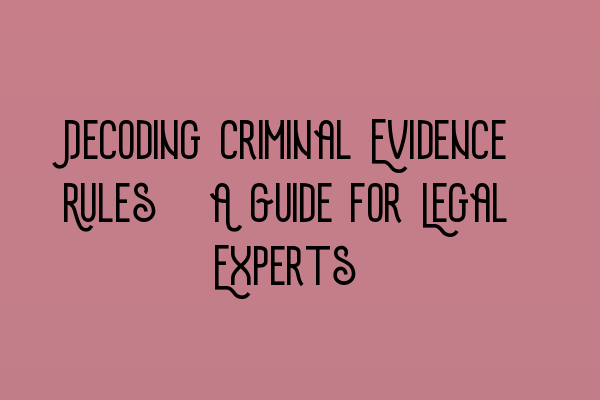Decoding Criminal Evidence Rules: A Guide for Legal Experts
As a legal expert in criminal law, it is crucial to have a solid understanding of the rules and principles surrounding criminal evidence. The admissibility and interpretation of evidence can make or break a case, ultimately determining the outcome for your clients. In this comprehensive guide, we will delve into the intricacies of decoding criminal evidence rules, equipping you with the knowledge and expertise necessary to navigate these complexities successfully.
The Importance of Criminal Evidence
Before delving into the rules, let’s understand why criminal evidence is so crucial in legal proceedings. Criminal evidence is any information or material that is presented in court to prove or disprove facts relevant to a criminal case. It serves as the foundation upon which arguments are built and decisions are made. It is essential for legal experts to have a deep understanding of the rules governing the admissibility and credibility of evidence to ensure a fair trial.
Types of Criminal Evidence
There are various types of evidence that can be presented in criminal cases. They include:
- Direct Evidence: This type of evidence directly proves or disproves a fact. It can take the form of eyewitness testimony, confessions, video recordings, or physical evidence.
- Circumstantial Evidence: Circumstantial evidence indirectly implies a fact, relying on inferences rather than direct proof. It requires the judge or jury to draw conclusions based on the available evidence.
- Character Evidence: Character evidence refers to evidence that focuses on the character or disposition of the defendant or victim. It can be admissible in some cases to establish credibility or propensity.
Now that we have a basic understanding of the types of evidence, let’s delve into the rules that govern their admissibility:
Relevance
The first and foremost rule for admissibility of evidence is relevance. Evidence must be relevant to the issues at hand and must have probative value. Irrelevant evidence may be excluded as it wastes precious time and can potentially prejudice the jury or judge.
When assessing relevance, legal experts must consider the logical connection between the evidence and the facts in dispute. It is essential to establish a clear nexus between the evidence and the elements of the crime or the defenses being presented.
Character Evidence Exceptions
Character evidence, as mentioned earlier, can be admissible in certain situations. However, there are exceptions to its admissibility. One important exception is when the defendant’s character is directly relevant to the crime charged. In such cases, the prosecution may introduce evidence of the defendant’s prior bad acts to establish a pattern of behavior.
It is crucial to understand the exceptions to character evidence and how they apply in different scenarios. This knowledge allows legal experts to effectively argue for or against its admissibility based on the specific circumstances of the case.
Hearsay Rule
The hearsay rule is one of the most important and complex rules of evidence. Hearsay refers to an out-of-court statement offered to prove the truth of the matter asserted. Generally, hearsay is considered inadmissible, as it is seen as second-hand information lacking in reliability.
However, there are exceptions to the hearsay rule. For example, statements made by a party to the case, statements made under certain business records exceptions, and statements made in the course of medical diagnosis or treatment may be admissible.
Legal experts must have a thorough understanding of the exceptions to the hearsay rule to effectively argue for or against the admissibility of statements made outside of the courtroom.
Authentication and Chain of Custody
Authentication and chain of custody are crucial aspects of admitting physical evidence. Evidence must be properly identified, marked, and stored to maintain its integrity and credibility. Legal experts need to establish a clear chain of custody to ensure that the evidence has not been tampered with or compromised in any way.
Authentication involves presenting evidence to prove that it is what it purports to be. This can be achieved through witness testimony, scientific analysis, or expert opinion. Legal experts must be well-versed in the methods of authentication to successfully admit physical evidence in court.
Conclusion
Understanding the intricate rules and principles surrounding criminal evidence is essential for legal experts practicing criminal law. By decoding these rules and having a comprehensive grasp of their application, you can effectively advocate for your clients and present a compelling case in court.
For more information and guidance on criminal law and practice, be sure to check out our related articles:
- SQE 1 Practice Exam Questions
- SQE 1 Practice Mocks FLK1 FLK2
- SQE 2 Preparation Courses
- SQE 1 Preparation Courses
- SRA SQE Exam Dates
By actively engaging with these resources, you can enhance your knowledge and stay up-to-date with the latest developments in criminal law practice.
